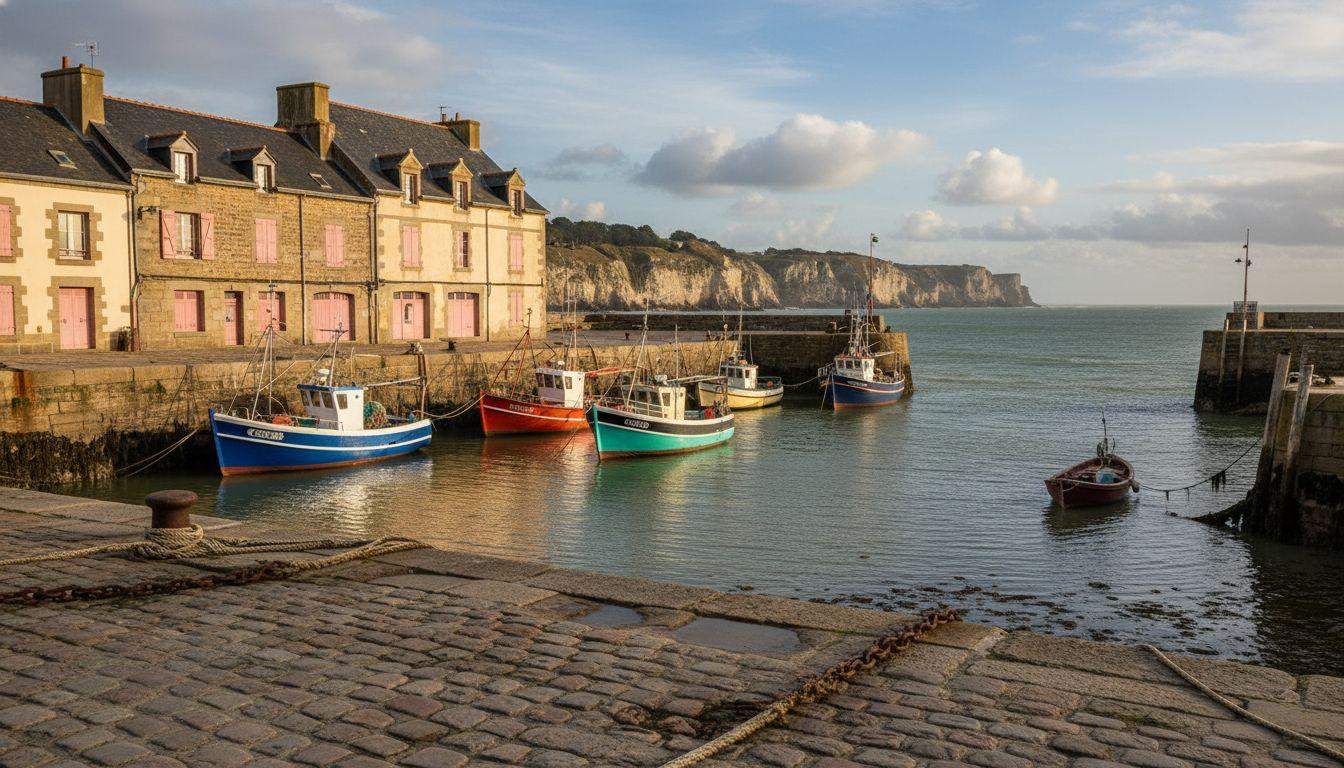Dawn breaks over Le Croisic’s harbor at 6:47 AM, golden light touching weathered fishing boats while Atlantic salt hangs in November air. Steam rises from the morning catch as 4,081 residents prepare for another day shaped by medieval tidal rhythms. This isn’t Brittany’s fortress-walled Saint-Malo drawing millions to rampart selfies 123 miles north. This is the Guérande Peninsula’s quieter truth: a working port where colorful boats return daily to stone quays unchanged since the 1500s, where seaweed cuisine thrives, and where the wild Côte Sauvage reveals why this authentic maritime village captivates those seeking France’s most genuine coastal experience.
Where Atlantic tides meet medieval stone
Le Croisic occupies the westernmost tip of the Guérande Peninsula, suspended between sheltered harbor and open Atlantic wilderness. The town spreads across 2.8 square miles at sea level, its golden limestone buildings rising directly from tidal waters that shift dramatically six times daily. From Nantes (31 miles east), the D213 coastal route reveals first glimpses: church spires above fishing boats, traditional pink-shuttered houses, and beyond: the dramatic cliffs of the Côte Sauvage.
At 47.2750° N, 2.7500° W, this geographic positioning creates Le Croisic’s dual personality. Protected eastern harbor where fishing boats dock unchanged for 500 years meets wild western coastline where Atlantic storms carve granite into hidden coves and dramatic overlooks.
The working port that tourism hasn’t changed
Maritime heritage since the 1500s
The fishing boats departing Le Croisic at 5:15 AM follow routes established when the port dominated Newfoundland cod fisheries. By 6:30 AM, the auction house buzzes with buyers examining sardines, langoustines, and the day’s catch. This isn’t reconstructed heritage: it’s continuous working life. The harbor’s colorful boats, weathered stone quays, and morning routines persist exactly as they did when Le Croisic earned its “Port of the Grand Banks” reputation four centuries ago.
Where seaweed becomes cuisine
October’s “Saveurs d’octobre” workshops reveal Le Croisic’s most distinctive tradition: seaweed gastronomy. Local chefs harvest dulse, sea lettuce, and kombu from rocky shores, transforming Atlantic plants into salads, soups, and surprising desserts. The nearby Guérande salt marshes provide fleur de sel that enhances every dish. This isn’t fusion experimentation: it’s centuries-old coastal cuisine most visitors never encounter.
The Côte Sauvage and hidden November magic
Where cliffs meet turquoise waters
The Sentier des Douaniers coastal path stretches 3 miles along dramatic cliffs rising 33-98 feet above turquoise Atlantic waters. November reveals what summer crowds obscure: hidden coves accessible only at low tide, granite formations sculpted by winter storms, and absolutely empty beaches where seabirds outnumber humans 100-to-1. Golden hour (4:30 PM in November) transforms the coastline into amber-lit drama: waves crashing against ancient rock, lighthouses blinking across empty horizons.
The Océarium and tidal discoveries
The Océarium du Croisic’s expanded shark tunnel (2025 renovation, $18-20 admission) offers underwater Atlantic perspectives: local species in recreated habitats, penguin colonies, and touch pools explaining tidal ecosystems. But the real discovery costs nothing: low tide exposes vast rocky platforms where locals harvest oysters, mussels, and periwinkles using techniques unchanged for generations. Similar coastal traditions persist along France’s Atlantic shores.
What Saint-Malo commercialized, Le Croisic preserved
While Saint-Malo’s ramparts frame 3 million annual selfies, Le Croisic’s visitors discover what authentic coastal Brittany means: morning fish auctions, seaweed cooking classes, and coastal paths empty except for wind and waves. The scale matters: 4,081 permanent residents maintain community rhythms that mass tourism destroys. Accommodations cost 40% less than Saint-Malo ($65-85 versus $110-155), meals emphasize local catch over tourist menus ($17-28 versus $33-50), and November reveals Le Croisic’s truest character.
A working maritime village that never stopped being itself. Similar authentic alternatives exist throughout France, quietly preserving traditions while famous neighbors embrace mass tourism.
Your questions about Le Croisic answered
How do I reach Le Croisic from major cities?
From Paris, the fastest route combines TGV to Nantes (2 hours, $55-90) and regional train to Le Croisic (1 hour, $11-17). From Nantes Atlantique Airport, rental cars cost $44-66 daily for the 31-mile drive (1 hour via D213). American travelers flying into Paris-CDG reach Le Croisic in 4-5 hours total travel time. November 2025 sees $17-22 shuttle services from Nantes airport to Guérande Peninsula destinations.
Why visit in November instead of summer?
November brings 54-64°F temperatures, 70% fewer crowds, and authentic harbor life visible when tourist activity pauses. The Côte Sauvage reveals its dramatic character: storm-sculpted cliffs, hidden tide pools, and seabird migrations. Hotels drop 30-40% ($65-85 versus summer’s $99-143), restaurants serve locals not tour groups, and the October seaweed workshops extend into early November. Working fishing ports worldwide show their authentic character during quieter months.
What makes Le Croisic different from Saint-Malo?
Saint-Malo’s fortress walls contain 3 million annual visitors; Le Croisic’s working port welcomes those who discover authentic maritime traditions. The contrast: commercialized rampart tourism versus genuine fishing harbor life, $155 hotels versus $77 guesthouses, tour-bus crowds versus tidal solitude on the Côte Sauvage. Le Croisic never became a museum. It remained a living port where 4,081 residents maintain rhythms synchronized with tides, not tourist seasons.
At 4:47 PM, November light turns Le Croisic’s harbor golden while fishing boats return with the evening tide. The scent of salt, seaweed, and fresh bread drifts from stone buildings unchanged since the 1600s. Beyond the protected harbor, the Côte Sauvage cliffs glow amber as Atlantic waves continue their timeless rhythm against ancient granite.
